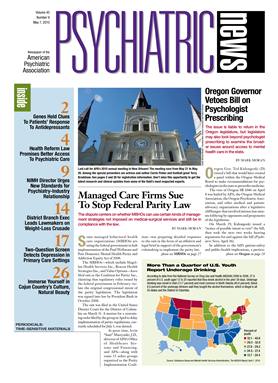Your depressed patient may have a potentially life-threatening sleep disorder.
A man taking prescribed antidepressant medication for eight years was referred for a sleep study only after his second driving crash. The study showed that he had obstructive sleep apnea (OSA), a disorder in which breathing stops repeatedly in sleep for 10 seconds or longer, lowering oxygen supply to the brain.
Another man's treatment-resistant depression forced him to quit work at age 45. He, too, was diagnosed later with severe OSA. Given first-line treatment for this disorder—use of continuous positive airway pressure (CPAP) to keep his airway open in sleep—the man's mood and cognition improved, along with his breathing. Restarting treatment with antidepressant medications brought further gains and enabled him to resume his career.
Mood-disorder prevalence rates in people with OSA in most studies range from about 30 percent to 50 percent, said Andrew Krystal, M.D., a professor of psychiatry and behavioral sciences and director of the insomnia and sleep research program at Duke University School of Medicine.
Psychiatrists likely have several patients with OSA in their practices, said Krystal, who co-chaired a conference in Washington, D.C., in March on sleep health and safety. The conference was sponsored by the National Sleep Foundation and the Atlanta School of Sleep Medicine.
Depression-related fatigue is hard to distinguish from excessive daytime sleepiness, the most common presenting symptom of OSA, he noted. “In our sleep-deprived society, it's easy to overlook sleepiness,” he said. Asking patients “Do you ever fall asleep without meaning to?” may help clarify their complaint.
Causes Go Beyond Obesity
An estimated 18 million adults in the United States have OSA, the National Sleep Foundation reports. OSA's prevalence has soared in recent years in tandem with the nation's expanding girth, said Meir Kryger, M.D., lead editor of the book Principles and Practice of Sleep Medicine. He is a professor of medicine at the University of Connecticut and director of sleep medicine research and education at Gaylord Hospital in Wallingford, Conn.
Two-thirds of American adults are overweight or obese, and excess fat can narrow the airway.
Even thin people may develop OSA, however, particularly those who have a small airway, large tongue, jaw deformities, or neurological disorders that reduce neuromuscular support for the airway in sleep.
OSA symptoms to explore in sleepy patients include snoring, observed pauses in breathing in sleep, difficulty concentrating and making decisions, morning headaches and dry mouth, impotence, and hypertension, Krystal said. Patients may not report difficulty sleeping, because brief interruptions in sleep often go unremembered in the morning. OSA boosts risks of heart disease, stroke, and premature death.
Initially thought to be more common in obese, middle-aged men, OSA occurs in both sexes and at all ages, said Kryger. It may be underdiagnosed in women, he added. In a review of charts of 130 women and 130 men matched for OSA of equal severity at time of diagnosis, he and his colleagues found both sexes had reported sleepiness, snoring, and observed pauses in breathing in sleep. Twenty-one percent of the women but only 7 percent of the men, however, had been diagnosed with depression. Women also took psychiatric medications more often than men.
Antidepressants Can Aggravate OSA
Antidepressants may, however, add to OSA symptom burden.
Some antidepressants complicate recognition of OSA by exacerbating sleepiness, Krystal said. Some worsen OSA by prompting weight gain.
A nonamphetamine wakefulness-promoting medication, armodafinil, may reduce sleepiness in patients with comorbid OSA and depression, Krystal and colleagues reported in the January Journal of Clinical Psychiatry. This trial was the first to assess armodafinil in patients receiving treatment for both disorders, Krystal said.
The 249 participants used CPAP and stable monotherapy with a serotonergic antidepressant throughout the 12-week, randomized, double-blind, parallel-group study, conducted at 60 outpatient sites from September 2007 to March 2009. The researchers assessed outcomes using standard depression and sleepiness scales, as well as overnight and daytime sleep studies. The armodafinil group improved more than the placebo group. Few participants developed worsening depression; none dropped out.
Motor-vehicle crashes are another risk in people with OSA.
“OSA is one of the few clinical entities of any sort associated with increased crashes and injuries in the transportation environment,” Mitchell Garber, M.D., M.P.H., a medical officer with the National Transportation Safety Board, said at the sleep conference. OSA has been implicated in performance errors by plane and ship pilots and drivers of trains, trucks, and automobiles.
Most states limit the right of individuals with medical conditions to drive, but only six states mention sleep disorders and only three name OSA, according to Allan Pack, M.B.Ch.B., Ph.D., a professor of medicine and chief of sleep medicine at the University of Pennsylvania School of Medicine.
Most states call for physicians to voluntarily report patients with medical conditions that may affect driving performance. While it is difficult to define who actually is at risk, Pack said, physicians need to warn patients who may be at risk and tell those who have had fall-asleep crashes to stop driving until assessed and effectively treated. CPAP therapy reduces OSA patients' crash risk.
People with OSA for whom CPAP has been prescribed need to use the device four or more hours per night to gain significant clinical benefits. Education, support, and counseling improve CPAP adherence.
“People with OSA need follow-up. This isn't unique in OSA. It's true of any chronic illness,” Gregory Belenky, M.D., a research professor of psychiatry and director of sleep and performance research at Washington State University, told Psychiatric News.
“Psychiatrists are attuned to encouraging patients to stick with treatment,” he noted. “They are used to working with patients' families, using behavioral interventions as well as medications, and adjusting therapy as necessary to improve outcomes,” all essential in treating people with OSA, Belenky said. Consultation-liaison psychiatry, he predicted, will expand its role in sleep medicine.

